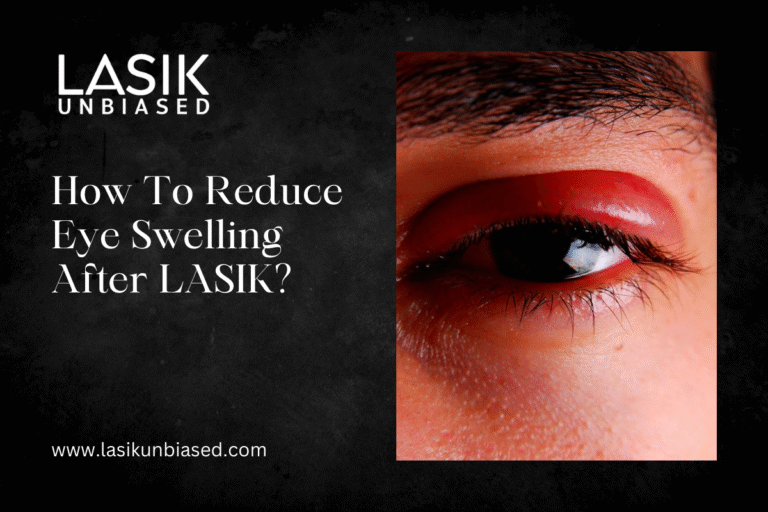To reduce eye swelling after LASIK, it is important to follow your surgeon’s post-operative care instructions and avoid activities that could strain your eyes.
Proper rest, eye hygiene, and using prescribed eye drops are essential for recovery.
LASIK eye surgery offers life-changing improvements in vision, but like any surgical procedure, post-operative care plays a key role in ensuring a smooth recovery. One common yet temporary side effect of LASIK is slight eye swelling. While it’s entirely normal and usually resolves quickly, taking the right steps can help reduce discomfort. Here’s everything you need to know to manage and minimise swelling after LASIK.
Why Does Eye Swelling Happen After LASIK?
Understanding the Cause
During LASIK, the surgeon creates a thin flap in the cornea, followed by reshaping the tissue underneath to improve vision. This precise and minimally invasive procedure can sometimes lead to inflammation in the corneal tissues, resulting in temporary swelling. Swelling is simply your body’s way of healing from the surgical intervention.
Other Contributing Factors
- Sensitivity to light: Post-procedure sensitivity can strain the eyes, exacerbating swelling.
- Dry eyes: LASIK can temporarily reduce tear production, creating discomfort and inflammation.
- Excessive rubbing of the eyes: Patients who inadvertently rub their eyes may worsen the issue, delaying recovery.
Understanding these factors is the first step in actively reducing eye swelling and ensuring a smooth healing process.
Essential Post-LASIK Care Tips to Reduce Swelling
1. Stick to Your Prescribed Medication
Post-surgery, your ophthalmologist will typically provide medicated eye drops, often a combination of antibiotics and steroid drops, to address inflammation and prevent infection. It’s important to use these drops exactly as prescribed to minimise swelling and protect your eyes while they heal.
- Use lubricating drops regularly to combat dryness, a common side effect.
- Avoid skipping doses to ensure consistent relief and protection.
If you have concerns about side effects or the effectiveness of the prescribed eye drops, consult your doctor instead of discontinuing them prematurely.
2. Avoid Eye Rubbing
LASIK makes your eyes more delicate temporarily, and even casual rubbing can disturb the healing corneal flap. Rubbing the eyes may not only increase swelling but also increase the risk of complications like infection or flap dislodgement.
- If you feel discomfort, use artificial tears for soothing relief.
- Ensure your hands remain clean and refrain from touching your eyes unnecessarily.
3. Apply Cold Compresses Carefully
A cold compress can help reduce mild swelling and soothe discomfort. Here’s how to use it properly without causing harm:
- Use a clean, soft cloth or cotton pad.
- Dip it in chilled (not icy) water and gently place it over your closed eyes. Do not press or apply pressure.
- Limit application to 10-15 minutes, and ensure the compress is not too cold to avoid irritating your sensitive skin.
Be sure to consult your surgeon before using compresses, as different patients may require tailored advice.
4. Take Time to Rest Your Eyes
Adequate rest is vital for healing after LASIK, especially in the first 24–48 hours. Avoid straining your eyes by minimising screen use, reading, or exposure to bright light in the immediate post-surgery phase.
- Sleep with protective goggles provided by your doctor to prevent accidental touching during the night.
- Incorporate breaks between activities to reduce eye fatigue.
5. Ensure Proper Hydration and Adhere to a Balanced Diet
Proper nutrition can accelerate healing and reduce swelling. Consume an adequate amount of water throughout the day to ensure proper hydration for your body and eyes. Incorporate the following nutrient-rich foods into your meals:
- Omega-3 fatty acids: Found in salmon, flaxseeds, and walnuts, they help reduce inflammation naturally.
- Vitamin C: Key for tissue repair, available in citrus fruits, bell peppers, and strawberries.
- Vitamin A: Promotes corneal health; found in carrots, sweet potatoes, and leafy greens.
Avoid consuming excessive salty or processed foods, as they can lead to dehydration and slow down recovery.
Activities to Avoid After LASIK to Minimise Swelling
1. Steer Clear of Water Exposure
Stay away from swimming pools, saunas, and hot tubs for at least two weeks post-surgery. The chemicals, bacteria, or general exposure to water vapours can irritate your healing eyes and lead to swelling.
- When showering, be cautious to keep water from coming into direct contact with your eyes.
- Avoid applying eye makeup during the first week, as residue can irritate the eyes.
2. Limit Screen Time
Extended periods of looking at screens can contribute to digital eye strain, exacerbating post-LASIK swelling.
- Take frequent breaks following the 20-20-20 rule; every 20 minutes, look at an object 20 feet away for 20 seconds.
- Adjust screen brightness to avoid further discomfort.
3. Avoid Heavy Lifting or Vigorous Exercise
Strenuous physical activities can increase intraocular pressure, prolonging swelling after LASIK. Light walking is fine, but intense gym sessions or heavy lifting should wait until your doctor gives you the green light.
When to Contact Your Surgeon?
While mild swelling is expected after LASIK, certain symptoms may signal a complication that requires immediate attention. Kindly contact your surgeon should you experience any of the following:
- Persistent or increasing pain that doesn’t subside with medication.
- Significant swelling accompanied by redness or discharge.
- Sudden vision loss, double vision, or halos that worsen over time.
Follow-up appointments are a vital part of the recovery process. Ensure you attend all scheduled visits so your doctor can ensure that your healing is on track and address any concerns.
Make Healing a Priority After LASIK
LASIK’s benefits are extraordinary, but the success of your procedure depends significantly on how well you adhere to post-operative care. By prioritising eye hygiene, consistency with medication, and rest, you can effectively minimise swelling and promote a faster recovery.
The key to a smooth post-LASIK recovery is understanding your body’s needs and taking proactive steps towards healing. If you’re planning for LASIK or are currently in your recovery stage, remember that proper care goes hand in hand with long-term visual health.


